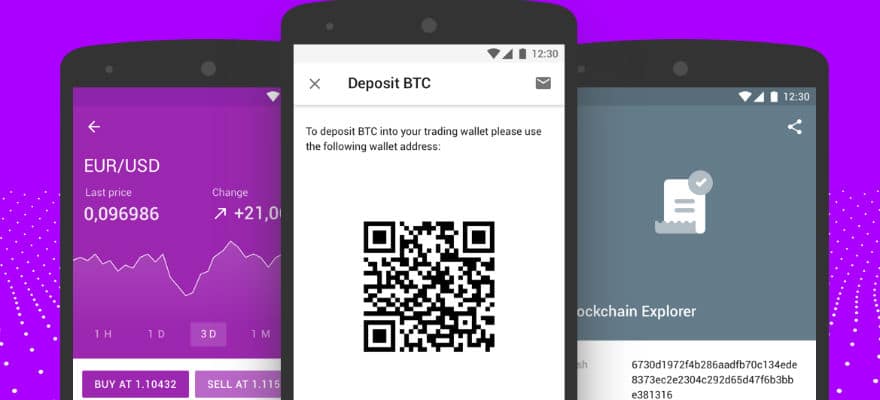When Lykke, a Swiss fintech startup building a Blockchain
Blockchain
Blockchain comprises a digital network of blocks with a comprehensive ledger of transactions made in a cryptocurrency such as Bitcoin or other altcoins.One of the signature features of blockchain is that it is maintained across more than one computer. The ledger can be public or private (permissioned). In this sense, blockchain is immune to the manipulation of data, making it not only open but verifiable. Because a blockchain is stored across a network of computers, it is very difficult to tamp
Blockchain comprises a digital network of blocks with a comprehensive ledger of transactions made in a cryptocurrency such as Bitcoin or other altcoins.One of the signature features of blockchain is that it is maintained across more than one computer. The ledger can be public or private (permissioned). In this sense, blockchain is immune to the manipulation of data, making it not only open but verifiable. Because a blockchain is stored across a network of computers, it is very difficult to tamp
Read this Term marketplace, released a version of its cryptocurrency wallet app for iOS, one of the main sources of credibility that drew us to the news was the man behind the venture. Richard Olsen, founder and CEO of Lykke, has co-founded OANDA and is a former CEO of the North American FX brokerage.
Join the industry leaders at the Finance Magnates London Summit, 14-15 November, 2016. Register here!
Olsen founded Lykke in Zurich and received initial seed funding in 2015. In May 2016, Lykke closed a second seed round where the new shareholders included angel investors Marco Brockhaus and Carlo Koelzer, founding partner of 360T’s Group Executive Board and member of Deutsche Börse Group Management Committee.
Finance Magnates recently talked with Olsen about his FX and blockchain entrepreneurship, the intersections between the two industries and much more.
Why did you make the move between online forex trading and the blockchain world?
I have always wanted to transform foreign exchange markets into a level playing field, where everyone has equal access and can trade with ultra-thin spreads. I have been looking for a technical solution that could turn the dream into reality. In 2011, I discovered that blockchain technology was ‘the’ answer – so it was only a matter of time to find the right opportunity to launch the initiative.
What do you see as the main differences between setting up OANDA back in the day and founding a blockchain company these days?
When we launched OANDA, everything was early days and nobody had any fintech experience – we were true pioneers. Even worse, foreign exchange markets were the exclusive domain of professionals and not accessible to retail traders. Initially, it was very difficult to get foreign exchange market prices that we could stream in real time to our users over the Internet.
Did your previous success help in attracting investors to the new venture?
My previous experience has been very useful - investors know that I have hands on experience, an important asset for any startup, but especially so for a fintech company, which has to balance technological innovation with regulatory requirements.
Do you think that we will eventually see any merging of the two worlds?
The two worlds will merge completely – blockchain will absorb the old world. Blockchain is the answer to the many issues that plague our financial system.
So what role will be left for margin FX brokers in this new blockchain world?
The number of instruments and volume traded will explode; there will be three exciting business opportunities: retail traders will look to fx brokers as community and event organizers to gamify trading and to socialize with other traders. FX brokers will increasingly become community builders. This will provide them the opportunity to market third-party investment products and launch their own investment products.
What are the deficiencies in the traditional finance business that you think Bitcoin can fix?
Traditional finance builds on business processes that assume paper-based processing and postmen delivering of trade confirmations. This is the reason, why there is two and more days delay in the settlement of trades. There are no intra-day interest Payments
Payments
One of the bases of mediums of exchange in the modern world, a payment constitutes the transfer of a legal currency or equivalent from one party in exchange for goods or services to another entity. The payments industry has become a fixture of modern commerce, though the players involved and means of exchange have dramatically shifted over time.In particular, a party making a payment is referred to as a payer, with the payee reflecting the individual or entity receiving the payment. Most commonl
One of the bases of mediums of exchange in the modern world, a payment constitutes the transfer of a legal currency or equivalent from one party in exchange for goods or services to another entity. The payments industry has become a fixture of modern commerce, though the players involved and means of exchange have dramatically shifted over time.In particular, a party making a payment is referred to as a payer, with the payee reflecting the individual or entity receiving the payment. Most commonl
Read this Term and transaction costs are huge, which reduces liquidity and stands in the way of market access for new instruments. And there is no direct ownership of assets; we need to rely on intermediaries. Traditional finance is comparable to the nervous system of dinosaurs. Blockchain can fix all this – we will build a seamless financial system.
What businesses are most in danger of being disrupted by blockchain technology?
Blockchain is an opportunity for all businesses – literally all businesses can embrace the technology and seize the opportunities, such as issuance of new instruments, explosive growth of transaction volumes, new types of banking, investment management and insurance products - these markets have huge potential. Companies that close their eyes to the new opportunities are at risk – they will be latecomers and will have to restructure, when revenues nosedive – a bad environment to embrace new business models.
Cyber security seems like a major problem for Bitcoin exchanges at the moment. How do you assure clients that they can trust Lykke?
The existing Bitcoin exchanges trade the ‘commodity’, which is Bitcoin. If the private key that safeguards the Bitcoin is hacked, then the commodity is lost. We rely on so-called ‘colored coins’ – which is like trading traditional bank notes or share certificates printed on paper: we use a piece of Bitcoin to specify the content of colored coin, we do not use paper. If a colored coin is hacked, the issuer cancels the colored coin and issues a new colored coin. The thief has stolen a colored coin that has lost its value. We do not face the problem of cyber security of Bitcoin exchanges.
There is another big difference; the Lykke exchange does not take custody of client funds. We protect customer funds by requiring two signatures from both the exchange and the client for any transaction; a hacker cannot steal assets with one private key; he needs two private keys. Second, if for any reason our exchange goes down, there is a refund mechanism for the second private key held by Lykke. We have solved the cyber security issue that plagues the Bitcoin exchanges and offer restitution, which is more efficient than a depositor insurance scheme in banks that is limited to specified amount of money.
What do you make of the attack on Bitfinex?
The Bitfinex loss is typical for the growing pains of a new industry. I have opted for a novel management structure due to the complexity of building a new business with a novel technology. Lykke is an emergent organization, where all our software is open source and crowd-based. We do this to attract the best talent and develop robust products and services.
In the couple of days ahead of the announcement the price of Bitcoin fell from around $650 to around $600. Do you suspect that insiders sold or shorted Bitcoin before Bitfinex came out with the news?
I would be surprised, if this was the case; but anything is possible. If I had time, I would analyze the transaction records of Bitcoin exchanges to investigate the issue.
Aren’t centralized exchanges too much of a valuable target to hackers and a single point of failure to the network? Would it not be better to just switch to a decentralized model completely?
Centralization per se is not the issue – centralization of the matching engine is a requirement for optimal price discovery. The exchange needs to be semi-centralized: the exchange should not be allowed to be the custodian of client assets and processing of trades has to be based on two of two signatures from the exchange and client. This is the Lykke architecture.
How has the market reception for the Lykke wallet on iOS been so far?
We have received a lot of praise for the user-friendliness of our wallet – we know that we are on the right track; I love the thrill of developing a product that has the potential to go viral.
When Lykke, a Swiss fintech startup building a Blockchain
Blockchain
Blockchain comprises a digital network of blocks with a comprehensive ledger of transactions made in a cryptocurrency such as Bitcoin or other altcoins.One of the signature features of blockchain is that it is maintained across more than one computer. The ledger can be public or private (permissioned). In this sense, blockchain is immune to the manipulation of data, making it not only open but verifiable. Because a blockchain is stored across a network of computers, it is very difficult to tamp
Blockchain comprises a digital network of blocks with a comprehensive ledger of transactions made in a cryptocurrency such as Bitcoin or other altcoins.One of the signature features of blockchain is that it is maintained across more than one computer. The ledger can be public or private (permissioned). In this sense, blockchain is immune to the manipulation of data, making it not only open but verifiable. Because a blockchain is stored across a network of computers, it is very difficult to tamp
Read this Term marketplace, released a version of its cryptocurrency wallet app for iOS, one of the main sources of credibility that drew us to the news was the man behind the venture. Richard Olsen, founder and CEO of Lykke, has co-founded OANDA and is a former CEO of the North American FX brokerage.
Join the industry leaders at the Finance Magnates London Summit, 14-15 November, 2016. Register here!
Olsen founded Lykke in Zurich and received initial seed funding in 2015. In May 2016, Lykke closed a second seed round where the new shareholders included angel investors Marco Brockhaus and Carlo Koelzer, founding partner of 360T’s Group Executive Board and member of Deutsche Börse Group Management Committee.
Finance Magnates recently talked with Olsen about his FX and blockchain entrepreneurship, the intersections between the two industries and much more.
Why did you make the move between online forex trading and the blockchain world?
I have always wanted to transform foreign exchange markets into a level playing field, where everyone has equal access and can trade with ultra-thin spreads. I have been looking for a technical solution that could turn the dream into reality. In 2011, I discovered that blockchain technology was ‘the’ answer – so it was only a matter of time to find the right opportunity to launch the initiative.
What do you see as the main differences between setting up OANDA back in the day and founding a blockchain company these days?
When we launched OANDA, everything was early days and nobody had any fintech experience – we were true pioneers. Even worse, foreign exchange markets were the exclusive domain of professionals and not accessible to retail traders. Initially, it was very difficult to get foreign exchange market prices that we could stream in real time to our users over the Internet.
Did your previous success help in attracting investors to the new venture?
My previous experience has been very useful - investors know that I have hands on experience, an important asset for any startup, but especially so for a fintech company, which has to balance technological innovation with regulatory requirements.
Do you think that we will eventually see any merging of the two worlds?
The two worlds will merge completely – blockchain will absorb the old world. Blockchain is the answer to the many issues that plague our financial system.
So what role will be left for margin FX brokers in this new blockchain world?
The number of instruments and volume traded will explode; there will be three exciting business opportunities: retail traders will look to fx brokers as community and event organizers to gamify trading and to socialize with other traders. FX brokers will increasingly become community builders. This will provide them the opportunity to market third-party investment products and launch their own investment products.
What are the deficiencies in the traditional finance business that you think Bitcoin can fix?
Traditional finance builds on business processes that assume paper-based processing and postmen delivering of trade confirmations. This is the reason, why there is two and more days delay in the settlement of trades. There are no intra-day interest Payments
Payments
One of the bases of mediums of exchange in the modern world, a payment constitutes the transfer of a legal currency or equivalent from one party in exchange for goods or services to another entity. The payments industry has become a fixture of modern commerce, though the players involved and means of exchange have dramatically shifted over time.In particular, a party making a payment is referred to as a payer, with the payee reflecting the individual or entity receiving the payment. Most commonl
One of the bases of mediums of exchange in the modern world, a payment constitutes the transfer of a legal currency or equivalent from one party in exchange for goods or services to another entity. The payments industry has become a fixture of modern commerce, though the players involved and means of exchange have dramatically shifted over time.In particular, a party making a payment is referred to as a payer, with the payee reflecting the individual or entity receiving the payment. Most commonl
Read this Term and transaction costs are huge, which reduces liquidity and stands in the way of market access for new instruments. And there is no direct ownership of assets; we need to rely on intermediaries. Traditional finance is comparable to the nervous system of dinosaurs. Blockchain can fix all this – we will build a seamless financial system.
What businesses are most in danger of being disrupted by blockchain technology?
Blockchain is an opportunity for all businesses – literally all businesses can embrace the technology and seize the opportunities, such as issuance of new instruments, explosive growth of transaction volumes, new types of banking, investment management and insurance products - these markets have huge potential. Companies that close their eyes to the new opportunities are at risk – they will be latecomers and will have to restructure, when revenues nosedive – a bad environment to embrace new business models.
Cyber security seems like a major problem for Bitcoin exchanges at the moment. How do you assure clients that they can trust Lykke?
The existing Bitcoin exchanges trade the ‘commodity’, which is Bitcoin. If the private key that safeguards the Bitcoin is hacked, then the commodity is lost. We rely on so-called ‘colored coins’ – which is like trading traditional bank notes or share certificates printed on paper: we use a piece of Bitcoin to specify the content of colored coin, we do not use paper. If a colored coin is hacked, the issuer cancels the colored coin and issues a new colored coin. The thief has stolen a colored coin that has lost its value. We do not face the problem of cyber security of Bitcoin exchanges.
There is another big difference; the Lykke exchange does not take custody of client funds. We protect customer funds by requiring two signatures from both the exchange and the client for any transaction; a hacker cannot steal assets with one private key; he needs two private keys. Second, if for any reason our exchange goes down, there is a refund mechanism for the second private key held by Lykke. We have solved the cyber security issue that plagues the Bitcoin exchanges and offer restitution, which is more efficient than a depositor insurance scheme in banks that is limited to specified amount of money.
What do you make of the attack on Bitfinex?
The Bitfinex loss is typical for the growing pains of a new industry. I have opted for a novel management structure due to the complexity of building a new business with a novel technology. Lykke is an emergent organization, where all our software is open source and crowd-based. We do this to attract the best talent and develop robust products and services.
In the couple of days ahead of the announcement the price of Bitcoin fell from around $650 to around $600. Do you suspect that insiders sold or shorted Bitcoin before Bitfinex came out with the news?
I would be surprised, if this was the case; but anything is possible. If I had time, I would analyze the transaction records of Bitcoin exchanges to investigate the issue.
Aren’t centralized exchanges too much of a valuable target to hackers and a single point of failure to the network? Would it not be better to just switch to a decentralized model completely?
Centralization per se is not the issue – centralization of the matching engine is a requirement for optimal price discovery. The exchange needs to be semi-centralized: the exchange should not be allowed to be the custodian of client assets and processing of trades has to be based on two of two signatures from the exchange and client. This is the Lykke architecture.
How has the market reception for the Lykke wallet on iOS been so far?
We have received a lot of praise for the user-friendliness of our wallet – we know that we are on the right track; I love the thrill of developing a product that has the potential to go viral.






















